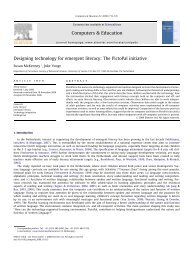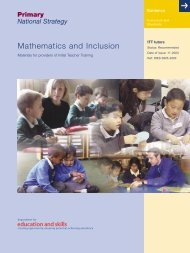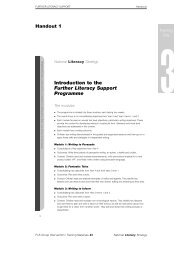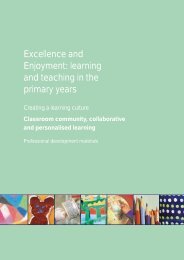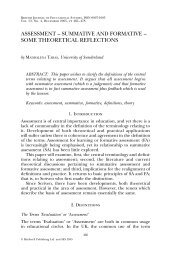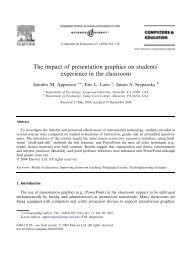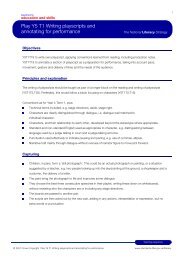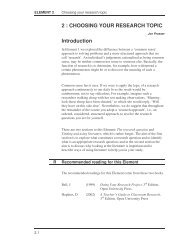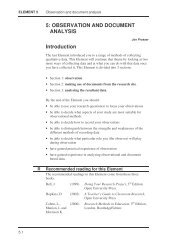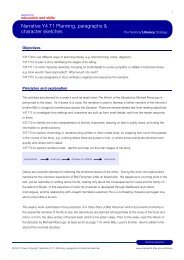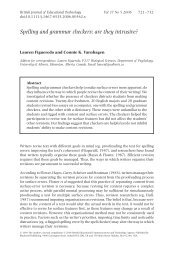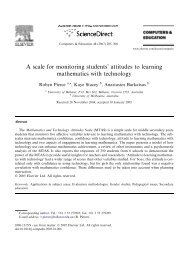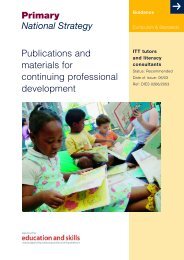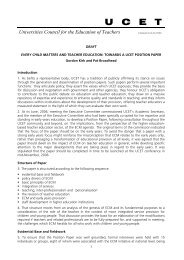Unit 5a Plan and resources - PGCE
Unit 5a Plan and resources - PGCE
Unit 5a Plan and resources - PGCE
Create successful ePaper yourself
Turn your PDF publications into a flip-book with our unique Google optimized e-Paper software.
<strong>Unit</strong> 5 part 1<br />
Fractions, decimals <strong>and</strong> percentages<br />
Five daily lessons<br />
Year 6<br />
Spring term<br />
<strong>Unit</strong> Objectives<br />
Year 6<br />
● Order fractions by converting them to fractions with a Page 23<br />
common denominator, <strong>and</strong> position them on a number line.<br />
● Use a fraction as an ‘operator’ to find fractions of numbers Page 25<br />
or quantities.<br />
● Change a fraction to the equivalent mixed number. Page 23<br />
This <strong>Unit</strong> <strong>Plan</strong> is designed<br />
to guide your teaching.<br />
You will need to adapt it to<br />
meet the needs of your class.<br />
●<br />
●<br />
●<br />
●<br />
● Begin to convert a fraction to decimal using division. Page 31<br />
● Express simple fractions as percentages. Page 33<br />
● Find simple percentages of small whole number quantities. Page 33<br />
● Develop calculator skills <strong>and</strong> use a calculator effectively. Page 71<br />
Link Objectives<br />
Year 5 Year 7<br />
Order a set of fractions <strong>and</strong> position them<br />
on a number line.<br />
Relate fractions to division, <strong>and</strong> use<br />
division to find simple fractions of numbers<br />
<strong>and</strong> quantities.<br />
Relate fractions to their decimal<br />
representations.<br />
Begin to underst<strong>and</strong> percentage as the<br />
number of parts in every 100.<br />
●<br />
●<br />
Use fraction notation to describe<br />
parts of shapes <strong>and</strong> to express a<br />
smaller whole number as a fraction<br />
of a larger one.<br />
Recognise the equivalence of<br />
percentages, fractions <strong>and</strong><br />
decimals.<br />
Resources needed to teach this unit:<br />
●<br />
●<br />
●<br />
●<br />
●<br />
●<br />
Resource sheet 5pt.1.1<br />
Whiteboards<br />
Counting stick<br />
OHP calculator<br />
Calculators<br />
Related Key Stage 2 National<br />
test questions<br />
(Key objectives in bold)<br />
NNS <strong>Unit</strong> <strong>Plan</strong>s
<strong>Plan</strong>ning<br />
sheet<br />
Day One <strong>Unit</strong> 5pt.1 Fractions, decimals <strong>and</strong><br />
percentages<br />
Oral <strong>and</strong> Mental<br />
Main Teaching<br />
Objectives <strong>and</strong> Teaching Activities<br />
Objectives <strong>and</strong><br />
Vocabulary<br />
Vocabulary<br />
Know simple fractions<br />
as percentages/<br />
decimals.<br />
●<br />
●<br />
Use the counting stick marked from 0 to<br />
1. Point to a division <strong>and</strong> ask what<br />
fraction is this? Repeat asking for values<br />
as decimals <strong>and</strong> percentages.Then ask<br />
questions like:<br />
Q If this is 1 ⁄4 what is that as a<br />
decimal/percentage?<br />
Q If this is 1 ⁄5 what is that as a<br />
decimal/percentage?<br />
Write the number 400 on the board.<br />
Ask children for 1 ⁄2 of 400, 1 ⁄4 of 400 <strong>and</strong><br />
then 50%, 25% of 400. Link these to<br />
0·5 × 400, 0·25 × 400 <strong>and</strong> repeat with 1 ⁄5<br />
<strong>and</strong> 1 ⁄10.<br />
Begin to convert fractions to<br />
decimals using division.<br />
Develop calculator skills <strong>and</strong> use<br />
a calculator effectively.<br />
VOCABULARY<br />
ascending<br />
numerator<br />
denominator<br />
equivalent<br />
●<br />
●<br />
●<br />
●<br />
Term: Spring Year Group: 6<br />
Teaching Activities<br />
Write these fractions on the board:<br />
1<br />
⁄10, 1 ⁄5, 4 ⁄10, 5 ⁄8, 9 ⁄16.<br />
Q Which fraction is bigger than 3 ⁄5 <strong>and</strong> why?<br />
Establish that 1 ⁄10, 1 ⁄5 <strong>and</strong> 4 ⁄10 are smaller than 3 ⁄5.<br />
Q How could we compare the size of 4 ⁄10 <strong>and</strong> 3 ⁄5?<br />
Remind the children that tenths are easy to convert to decimals <strong>and</strong><br />
1<br />
⁄10 = 0·1, 4 ⁄10 = 0·4.<br />
Q What is 1 ⁄5 in tenths?<br />
Establish it is 2 ⁄10 <strong>and</strong> 2 ⁄10 = 0·2.<br />
Use an OHP calculator <strong>and</strong> demonstrate how to convert 1 ⁄5 to a<br />
decimal using division.<br />
Get the children to convert 1 ⁄10, 4 ⁄10, 3 ⁄5 with their calculators.<br />
Q How does this help us to compare fractions?<br />
Ask the children to convert 5 ⁄8 <strong>and</strong> 9 ⁄16 to decimals <strong>and</strong> write the<br />
answers on the board. Establish that 9 ⁄16 is smaller than 3 ⁄5. Write the<br />
five fractions in order of size, smallest first.<br />
Write 6 ⁄7 <strong>and</strong> 5 ⁄6 on the board. Get children to convert them to decimals<br />
<strong>and</strong> discuss the calculator displays. Remind the children the answer<br />
on the display is only part of the decimal representation. Order the<br />
two fractions.<br />
Give the children groups of fractions <strong>and</strong> ask them to convert them to<br />
decimals <strong>and</strong> then order them, e.g. 2 ⁄7, 1 ⁄5, 3 ⁄8.<br />
Collect answers <strong>and</strong> correct errors.<br />
Plenary<br />
Teaching Activities / Focus<br />
Questions<br />
● Write 5 ⁄11 on the board. Invite<br />
children to write a fraction on the<br />
board that they think is smaller<br />
than 5 ⁄11.<br />
●<br />
●<br />
Q Is this correct? How do you<br />
know?<br />
Check whether they are right by<br />
using the OHP calculator. Repeat<br />
with another fraction <strong>and</strong> ask for<br />
bigger <strong>and</strong> smaller fractions.<br />
Write 1 ⁄2, 2 ⁄3, 5 ⁄6, 1 ⁄4 on the board.<br />
Ask the children to sort them in<br />
ascending order.<br />
Q What is the correct order?<br />
Did you use a calculator; if<br />
you didn’t how did you do it?<br />
Ask the children to think of four<br />
fractions that they would not need<br />
a calculator to help sort.<br />
Take responses.<br />
By the end of the lesson the<br />
children should be able to:<br />
● Enter fractions into a<br />
calculator <strong>and</strong> interpret the<br />
display to find the equivalent<br />
decimal;<br />
● Predict the result before<br />
confirming;<br />
● Use a calculator to compare<br />
fractions.<br />
(Refer to supplement of<br />
examples, section 6, page 31.)<br />
RESOURCES<br />
Counting stick<br />
RESOURCES<br />
Calculators<br />
OHP calculator<br />
NNS <strong>Unit</strong> <strong>Plan</strong>s
<strong>Plan</strong>ning<br />
sheet<br />
Day Two <strong>Unit</strong> 5pt.1 Fractions, decimals <strong>and</strong><br />
percentages<br />
Oral <strong>and</strong> Mental<br />
Main Teaching<br />
Objectives <strong>and</strong> Teaching Activities<br />
Objectives <strong>and</strong><br />
Vocabulary<br />
Vocabulary<br />
Order fractions. ● Shuffle the fraction cards on Resource<br />
sheet 5pt.1.1.<br />
Choose four cards at r<strong>and</strong>om <strong>and</strong> ask<br />
four children to come out <strong>and</strong> hold up the<br />
cards. Ask the class to put the ‘fraction<br />
children’ in order.<br />
●<br />
Shuffle the pack <strong>and</strong> repeat this with four<br />
other cards. If two cards show the<br />
equivalent fractions, get the children to<br />
identify these <strong>and</strong> select another card.<br />
Order fractions by converting<br />
them to a common denominator<br />
<strong>and</strong> position them on a number<br />
line.<br />
Develop calculator skills <strong>and</strong> use<br />
a calculator effectively.<br />
Term: Spring Year Group: 6<br />
Teaching Activities<br />
● Write on the board: 1 ⁄2, 1 ⁄3, 1 ⁄6.<br />
●<br />
Q How can we put these fractions in order without using a<br />
calculator?<br />
Ask children for:<br />
1<br />
⁄2 of 600, 1 ⁄3 of 600 <strong>and</strong> 1 ⁄6 of 600.<br />
Write these in brackets under the fractions <strong>and</strong> use the numbers 300,<br />
200, 100 to order the fractions.<br />
Get children to confirm the answers using calculators to convert the<br />
fractions to decimals.<br />
Write a number line on the board:<br />
1<br />
⁄6<br />
2<br />
⁄6 3 ⁄6<br />
4<br />
⁄6 5 ⁄6<br />
0 1<br />
Plenary<br />
Teaching Activities / Focus<br />
Questions<br />
●<br />
Remind the children that a fraction<br />
can be changed by multiplying/<br />
dividing both the numerator <strong>and</strong><br />
denominator by the same number.<br />
Write 30 ⁄50 on the board <strong>and</strong> ask<br />
children to give equivalents by<br />
multiplying <strong>and</strong> dividing.<br />
Q Are 12 ⁄18, 16 ⁄24, 40 ⁄90, 10 ⁄15<br />
equivalent?<br />
Ask children the numbers to divide<br />
the numerators <strong>and</strong> denominators<br />
by <strong>and</strong> convert each fraction to 2 ⁄3.<br />
HOMEWORK – Give the children the<br />
following nine fractions:<br />
16<br />
⁄20, 6 ⁄10, 20 ⁄25, 25 ⁄100, 15 ⁄25, 5 ⁄20, 24 ⁄40,<br />
VOCABULARY<br />
common denominator<br />
numerator<br />
denominator<br />
●<br />
●<br />
Q Where would 1 ⁄2 be? Where would 1 ⁄3, be? Why?<br />
Establish that 2 ⁄6 = 1 ⁄3 <strong>and</strong> 1 ⁄2 = 3 ⁄6 <strong>and</strong> check using the calculator.<br />
Emphasise that it is easier to order 3 ⁄6, 2 ⁄6 <strong>and</strong> 1 ⁄6 which have a<br />
common denominator. Discuss with the children the term common<br />
denominator. Give the children groups of fractions to order from<br />
smallest to largest by converting all to tenths, <strong>and</strong> position on a<br />
number line e.g. 3 ⁄10, 2 ⁄5, 1 ⁄2, 7 ⁄10, 4 ⁄5. Discuss their answers <strong>and</strong> methods.<br />
Repeat giving children other sets of fractions to convert to a common<br />
denominator <strong>and</strong> sort in order. Collect answers <strong>and</strong> correct errors.<br />
15<br />
⁄60, 80 ⁄100.<br />
Say these fractions form three sets of<br />
equivalent fractions. Ask the children<br />
to put the fractions in the sets.<br />
By the end of the lesson the<br />
children should be able to:<br />
● Recognise that:<br />
– a fraction can be reduced<br />
to an equivalent fraction<br />
by dividing both numerator<br />
<strong>and</strong> denominator by the<br />
same number;<br />
– a fraction can be<br />
changed to an equivalent<br />
fraction by multiplying<br />
both numerator <strong>and</strong><br />
denominator by the same<br />
number;<br />
● Compare <strong>and</strong> order simple<br />
fractions by converting them<br />
to a common denominator.<br />
RESOURCES<br />
Resource sheet 5pt.1.1<br />
RESOURCES<br />
OHP calculator<br />
Calculators<br />
(Refer to supplement of<br />
examples, section 6, page 23.)<br />
NNS <strong>Unit</strong> <strong>Plan</strong>s
<strong>Plan</strong>ning<br />
sheet<br />
Day Three <strong>Unit</strong> 5pt.1 Fractions, decimals <strong>and</strong><br />
percentages<br />
Oral <strong>and</strong> Mental<br />
Main Teaching<br />
Objectives <strong>and</strong> Teaching Activities<br />
Objectives <strong>and</strong><br />
Vocabulary<br />
Vocabulary<br />
Find halves of decimals<br />
with an even last digit.<br />
●<br />
●<br />
Ask the children a range of questions<br />
such as:<br />
Q What is half of 4·8?<br />
Q What is 0·78 divided by 2?<br />
Q What number would you double to<br />
get 0.12?<br />
Children write answers on whiteboards.<br />
Discuss the children’s answers <strong>and</strong> their<br />
strategies. On the board write:<br />
0·48<br />
Ask children to halve this. Write the<br />
answer under 0·48 <strong>and</strong> ask for half this.<br />
Repeat to form<br />
0·48<br />
0·24<br />
0·12<br />
0·06<br />
0·03<br />
Q What is the next number?<br />
Establish it is 0·015. Point to two numbers<br />
in the list <strong>and</strong> for the larger ask<br />
Q What would you divide this by to get<br />
the smaller number?<br />
Use a fraction as an operator to<br />
find fractions of numbers <strong>and</strong><br />
quantities.<br />
●<br />
●<br />
●<br />
Term: Spring Year Group: 6<br />
Teaching Activities<br />
Write £300 on the board. Say 2 ⁄5 of this goes on food, 3 ⁄10 goes on rent,<br />
the rest is for spending. How much is there to spend?<br />
Establish that finding 1 ⁄5 of £300 means divide by 5 to get £60, 2 ⁄5<br />
means 2 × £60 = £120. Work through the rest of the problem.<br />
Give the children this problem. A giant bar of chocolate is 600 cm<br />
long. Gemma has 1 ⁄5th of the bar, John has 2 ⁄10ths. How much is left?<br />
Allow the children to work in pairs to solve the problem.<br />
Q How did you find the answer?<br />
Work through similar problems. Collect answers <strong>and</strong> establish that to<br />
find a fraction of a quantity divide by the denominator <strong>and</strong> multiply by<br />
the numerator.<br />
Pose the problems:<br />
Jug A when full holds 1 litre<br />
Jug B when full holds 75ml<br />
Jug A is 11 ⁄20 full.<br />
Jug B is 5 ⁄6 full.<br />
Which has more liquid in it?<br />
Collect answers <strong>and</strong> discuss the children’s methods.<br />
Plenary<br />
Teaching Activities / Focus<br />
Questions<br />
● Write 120km on the board. Ask<br />
children to work out 1 ⁄12 of 120km,<br />
7<br />
⁄12 of 120km in their heads.<br />
Q What other fractions of<br />
120km can you work out in<br />
your heads?<br />
Repeat with 450kg. Ask children to<br />
work out 1 ⁄9 of 450kg, 7 ⁄9 etc..<br />
Remind children of the division <strong>and</strong><br />
multiplication method.<br />
By the end of the lesson the<br />
children should be able to:<br />
● Find fractions of numbers<br />
<strong>and</strong> quantities.<br />
(Refer to supplement of<br />
examples, section 6, page 25.)<br />
RESOURCES<br />
Whiteboards<br />
VOCABULARY<br />
denominator<br />
numerator<br />
NNS <strong>Unit</strong> <strong>Plan</strong>s
<strong>Plan</strong>ning<br />
sheet<br />
Day Four <strong>Unit</strong> 5pt.1 Fractions, decimals <strong>and</strong><br />
percentages<br />
Oral <strong>and</strong> Mental<br />
Main Teaching<br />
Objectives <strong>and</strong> Teaching Activities<br />
Objectives <strong>and</strong><br />
Vocabulary<br />
Vocabulary<br />
Find simple<br />
percentages.<br />
●<br />
●<br />
●<br />
Give children a range of percentage<br />
questions like:<br />
Q What is 50% of £100. What is 70%<br />
of 100cm?<br />
Children write their answers on<br />
whiteboards.<br />
Discuss the children’s answers <strong>and</strong><br />
methods.<br />
Write 600m on the board.<br />
Q What is 10% of 600m?<br />
Write on the board:<br />
10% is 60m<br />
Extend by asking 5% is?<br />
2.5% is?<br />
Use these to build up other percentages<br />
such as 35%.<br />
Q What is 27.5% of 600m?<br />
Change a fraction to an<br />
equivalent mixed number.<br />
Use a fraction as an operator to<br />
find fractions of numbers <strong>and</strong><br />
quantities.<br />
●<br />
●<br />
●<br />
Term: Spring Year Group: 6<br />
Teaching Activities<br />
Discuss the homework with the children.<br />
Q Which would you rather have: 3 ⁄5 of £10 or 2 ⁄3 of £12?<br />
Children discuss the problem in pairs. Ask the children how they<br />
worked it out.<br />
Say: A bar of chocolate costs 2 1 ⁄2 times more than it did 10 years ago.<br />
If it cost 20p then what does it cost now? Work through the problem<br />
with the children; record<br />
2 × 20p = 40p 1<br />
⁄2 × 20p = 10p<br />
Cost now is: 40p + 10p = 50p<br />
Give similar questions to children. Collect answers <strong>and</strong> correct errors.<br />
Remind children that 3 1 ⁄5 is called a mixed number.<br />
Q How many fifths in 3?<br />
Establish that there are 5 fifths in 1 so there are 15 in 3, <strong>and</strong> 3 1 ⁄5 is 16 ⁄5.<br />
Say this is an improper fraction. Give children other mixed numbers to<br />
convert, <strong>and</strong> change improper fractions back to mixed numbers.<br />
Q What is 2 1 ⁄3 as an improper fraction?<br />
Establish 2 1 ⁄3 = 7 ⁄3. Ask children to find 2 1 ⁄3 of 225m, using calculators.<br />
Compare 2 × 225 + 1 ⁄3 × 225 with 7 × (225 ÷ 3). Explain that these two<br />
methods give the same answer.<br />
Plenary<br />
Teaching Activities / Focus<br />
Questions<br />
●<br />
●<br />
Q What is 2 4 ⁄5 of 1 litre?<br />
With the children convert this to<br />
14<br />
⁄.5 of 1000ml <strong>and</strong> use calculators<br />
to find the answer.<br />
Give the children questions to<br />
assess their underst<strong>and</strong>ing of the<br />
vocabulary of fractions. Ask what<br />
these words mean:<br />
numerator<br />
denominator<br />
common denominator<br />
improper fraction<br />
mixed number.<br />
By the end of the lesson the<br />
children should be able to:<br />
● Find fractions of numbers<br />
<strong>and</strong> quantities.<br />
(Refer to supplement of<br />
examples, section 6, page 25.)<br />
VOCABULARY<br />
denominator<br />
numerator<br />
common denominator<br />
improper fraction<br />
mixed number<br />
RESOURCES<br />
Whiteboards<br />
RESOURCES<br />
Calculators<br />
NNS <strong>Unit</strong> <strong>Plan</strong>s
<strong>Plan</strong>ning<br />
sheet<br />
Day Five <strong>Unit</strong> 5pt.1 Fractions, decimals <strong>and</strong><br />
percentages<br />
Oral <strong>and</strong> Mental<br />
Main Teaching<br />
Objectives <strong>and</strong> Teaching Activities<br />
Objectives <strong>and</strong><br />
Vocabulary<br />
Vocabulary<br />
Find simple<br />
percentages.<br />
●<br />
●<br />
Write on the board the price of five items<br />
from a shop, e.g. £7.80.<br />
Tell the children that it’s ‘sale’ day <strong>and</strong> the<br />
prices have been reduced by 10%.<br />
Q What would 10% of each price be?<br />
Q What would the new price be?<br />
Children record their answers on<br />
whiteboards.<br />
Q If 10% of the cost of an item is 40p,<br />
what is the original cost?<br />
Express simple fractions as<br />
decimals <strong>and</strong> percentages.<br />
Find simple percentages of<br />
whole number quantities.<br />
Develop calculator skills <strong>and</strong> use<br />
a calculator effectively.<br />
●<br />
●<br />
Term: Spring Year Group: 6<br />
Teaching Activities<br />
Draw three number lines on the board:<br />
Explain that the first line represents fractions, the second line<br />
decimals <strong>and</strong> the third percentages. Point to a fraction on the first<br />
line e.g. 1 ⁄4. Ask children to mark the equivalents in decimals <strong>and</strong><br />
percentages. Repeat for other fractions, <strong>and</strong> start with a decimal <strong>and</strong><br />
a percentage.<br />
Q What is 10% of 300?<br />
0 1<br />
0 1<br />
0 100%<br />
Establish the answer is 30. Ask children to find 5%, 20%, 30% etc in<br />
their heads.<br />
Demonstrate how to find 35% of 300 on an OHP calculator.<br />
Q How can we find 6% of 300?<br />
300 × 35 %<br />
Get children to do this on their calculators.<br />
Remind children that 10% of 300 is 30 <strong>and</strong> 5% is 15 so 6% should be<br />
a bit more. Ask how they would find an estimate for 27% of 300. Get<br />
children to find 27% of 300 on their calculators.<br />
Plenary<br />
Teaching Activities / Focus<br />
Questions<br />
●<br />
●<br />
Ask the children for examples of<br />
questions where they used a<br />
calculator. Write them on the<br />
board.<br />
Q Can anyone think of ways we<br />
could do these mentally?<br />
Write 420 on the board.<br />
Ask children what percentages<br />
they can find in their heads. List<br />
these <strong>and</strong> discuss the methods<br />
the children use.<br />
Q When would you use a<br />
calculator?<br />
Take feedback.<br />
By the end of the lesson the<br />
children should be able to:<br />
● Without a calculator answer<br />
questions such as:<br />
find 25% of 300;<br />
● With a calculator answer<br />
questions such as:<br />
find 20% of £362.<br />
RESOURCES<br />
Whiteboards<br />
VOCABULARY<br />
equivalent<br />
percentages<br />
RESOURCES<br />
Calculators<br />
OHP calculator<br />
●<br />
Write the following on the board:<br />
70%<br />
10%<br />
45% 15%<br />
25%<br />
2% 35%<br />
60% 5%<br />
465<br />
130 520<br />
275<br />
615 320<br />
240<br />
760 1440<br />
The children have to choose a percentage from the first circle <strong>and</strong> a<br />
number from the second <strong>and</strong> work out the answer with a calculator or<br />
in their heads.<br />
Collect answers <strong>and</strong> discuss methods <strong>and</strong> estimates.<br />
(Refer to supplement of<br />
examples, section 6, page 33.)<br />
NNS <strong>Unit</strong> <strong>Plan</strong>s



